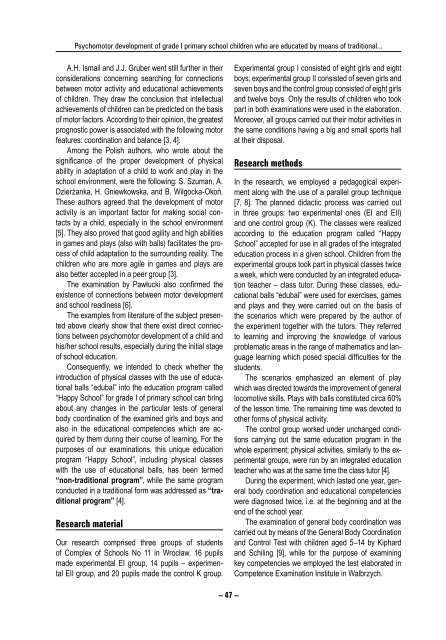full text - Akademia Wychowania Fizycznego w Krakowie
full text - Akademia Wychowania Fizycznego w Krakowie
full text - Akademia Wychowania Fizycznego w Krakowie
Create successful ePaper yourself
Turn your PDF publications into a flip-book with our unique Google optimized e-Paper software.
Psychomotor development of grade I primary school children who are educated by means of traditional...<br />
A.H. Ismail and J.J. Gruber went still further in their<br />
considerations concerning searching for connections<br />
between motor activity and educational achievements<br />
of children. They draw the conclusion that intellectual<br />
achievements of children can be predicted on the basis<br />
of motor factors. According to their opinion, the greatest<br />
prognostic power is associated with the following motor<br />
features: coordination and balance [3, 4].<br />
Among the Polish authors, who wrote about the<br />
signifi cance of the proper development of physical<br />
ability in adaptation of a child to work and play in the<br />
school environment, were the following: S. Szuman, A.<br />
Dzierżanka, H. Gniewkowska, and B. Wilgocka-Okoń.<br />
These authors agreed that the development of motor<br />
activity is an important factor for making social contacts<br />
by a child, especially in the school environment<br />
[5]. They also proved that good agility and high abilities<br />
in games and plays (also with balls) facilitates the process<br />
of child adaptation to the surrounding reality. The<br />
children who are more agile in games and plays are<br />
also better accepted in a peer group [3].<br />
The examination by Pawłucki also confi rmed the<br />
existence of connections between motor development<br />
and school readiness [6].<br />
The examples from literature of the subject presented<br />
above clearly show that there exist direct connections<br />
between psychomotor development of a child and<br />
his/her school results, especially during the initial stage<br />
of school education.<br />
Consequently, we intended to check whether the<br />
introduction of physical classes with the use of educational<br />
balls “edubal” into the education program called<br />
“Happy School” for grade I of primary school can bring<br />
about any changes in the particular tests of general<br />
body coordination of the examined girls and boys and<br />
also in the educational competencies which are acquired<br />
by them during their course of learning. For the<br />
purposes of our examinations, this unique education<br />
program “Happy School”, including physical classes<br />
with the use of educational balls, has been termed<br />
“non-traditional program”, while the same program<br />
conducted in a traditional form was addressed as “traditional<br />
program” [4].<br />
Research material<br />
Our research comprised three groups of students<br />
of Complex of Schools No 11 in Wrocław. 16 pupils<br />
made experimental EI group, 14 pupils – experimental<br />
EII group, and 20 pupils made the control K group.<br />
– 47 –<br />
Experimental group I consisted of eight girls and eight<br />
boys; experimental group II consisted of seven girls and<br />
seven boys and the control group consisted of eight girls<br />
and twelve boys. Only the results of children who took<br />
part in both examinations were used in the elaboration.<br />
Moreover, all groups carried out their motor activities in<br />
the same conditions having a big and small sports hall<br />
at their disposal.<br />
Research methods<br />
In the research, we employed a pedagogical experiment<br />
along with the use of a parallel group technique<br />
[7, 8]. The planned didactic process was carried out<br />
in three groups: two experimental ones (EI and EII)<br />
and one control group (K). The classes were realized<br />
according to the education program called “Happy<br />
School” accepted for use in all grades of the integrated<br />
education process in a given school. Children from the<br />
experimental groups took part in physical classes twice<br />
a week, which were conducted by an integrated education<br />
teacher – class tutor. During these classes, educational<br />
balls “edubal” were used for exercises, games<br />
and plays and they were carried out on the basis of<br />
the scenarios which were prepared by the author of<br />
the experiment together with the tutors. They referred<br />
to learning and improving the knowledge of various<br />
problematic areas in the range of mathematics and language<br />
learning which posed special diffi culties for the<br />
students.<br />
The scenarios emphasized an element of play<br />
which was directed towards the improvement of general<br />
locomotive skills. Plays with balls constituted circa 60%<br />
of the lesson time. The remaining time was devoted to<br />
other forms of physical activity.<br />
The control group worked under unchanged conditions<br />
carrying out the same education program in the<br />
whole experiment; physical activities, similarly to the experimental<br />
groups, were run by an integrated education<br />
teacher who was at the same time the class tutor [4].<br />
During the experiment, which lasted one year, general<br />
body coordination and educational competencies<br />
were diagnosed twice, i.e. at the beginning and at the<br />
end of the school year.<br />
The examination of general body coordination was<br />
carried out by means of the General Body Coordination<br />
and Control Test with children aged 5–14 by Kiphard<br />
and Schiling [9], while for the purpose of examining<br />
key competencies we employed the test elaborated in<br />
Competence Examination Institute in Walbrzych.





![Antropomotoryka nr 57 [2012]. - Akademia Wychowania Fizycznego ...](https://img.yumpu.com/50213388/1/182x260/antropomotoryka-nr-57-2012-akademia-wychowania-fizycznego-.jpg?quality=85)











